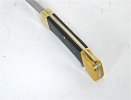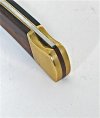-
The BladeForums.com 2024 Traditional Knife is ready to order! See this thread for details: https://www.bladeforums.com/threads/bladeforums-2024-traditional-knife.2003187/
Price is$300$250 ea (shipped within CONUS). If you live outside the US, I will contact you after your order for extra shipping charges.
Order here: https://www.bladeforums.com/help/2024-traditional/ - Order as many as you like, we have plenty.
You are using an out of date browser. It may not display this or other websites correctly.
You should upgrade or use an alternative browser.
You should upgrade or use an alternative browser.
Can you help me date this Buck 110
- Thread starter cocabill
- Start date
DeSotoSky
Gold Member
- Joined
- Mar 21, 2011
- Messages
- 6,774
Welcome to the Buck forum, your first post. Looks like a Fourth version Variation 1, 1970 -1972. You can find a word document outlining the variations in a sticky at the beginning of this forum.
(Bertl types faster than I do....there were not any responses when I started typing)
(Bertl types faster than I do....there were not any responses when I started typing)
Last edited:
bertl
Gold Member
- Joined
- Feb 17, 2011
- Messages
- 2,544
cocabill,
I need to have my memory refreshed. Is this the post you are talking about? If so, those are Stumps' photos although I made several comments.
Bert
http://www.bladeforums.com/forums/s...n-110-Collectors)-)?highlight=110+4th+version
I need to have my memory refreshed. Is this the post you are talking about? If so, those are Stumps' photos although I made several comments.
Bert
http://www.bladeforums.com/forums/s...n-110-Collectors)-)?highlight=110+4th+version
- Joined
- Dec 8, 2016
- Messages
- 1,343
Large pins, small pins, tiny pins, brass pins, high pins, low pins, nickel pins, headed pins, bowling pins.
I wonder if this era of the 110 and the multiplicity of late 60s early 70's oddities just means that many were made by guys reaching into their own miscellaneous parts box and these boxes were refilled overnight by the factory Hobbits with odd and forgotten parts they found in dusty back corners of the shop.
How can anyone be sure which is older or newer or just a one of a kind oddity just by looking?
It's all a wonderful mystery wrapped in a puzzle wrapped in an enigma.
I wonder if this era of the 110 and the multiplicity of late 60s early 70's oddities just means that many were made by guys reaching into their own miscellaneous parts box and these boxes were refilled overnight by the factory Hobbits with odd and forgotten parts they found in dusty back corners of the shop.
How can anyone be sure which is older or newer or just a one of a kind oddity just by looking?
It's all a wonderful mystery wrapped in a puzzle wrapped in an enigma.
Last edited:
- Joined
- Sep 29, 2015
- Messages
- 628
VorpalRain,
I read what you write and I like the way you put things. Somewhat carefree. There are Data sheets in the Stickies 110/112 to peg when the knife was made but you also must know somethings before the search begins, before the date codes started. I do believe that the inlay rivets were drilled and assembled at will, no form or function except to anchor the inlay. High or low it depended on the worker making the knife. I wonder if they had a quota to fulfill, so many knives a day or work at your own pace. They did eventually have templates to follow, but I'm talking about the very earliest knives. I know a person who collects early 110 knives and he told me that every worker had his own way to assemble the early knives.
Several things about earlier knives First thru Third versions were only a half inch wide, starting in the fourth they were made 9/16"- .562 wide. Early 110 knives had 2 brass inlay rivets, some had only 1 rear bolster rivet I believe just a short time. Like in the 4th version, Variation 1 has a brass rocker pin, Variation 2 has a stainless steel rocker pin.
The Data sheets are invaluable to get the correct Version and Variation, they do conform to these pieces and put them in a category dated each by years produced. The info that was compiled to form the data sheets for Early Buck 110/112 was done by Joe Houser.
'4f2e0c96-c073-4970-9fd3-9a33f7df8686_zpsjbymh


I read what you write and I like the way you put things. Somewhat carefree. There are Data sheets in the Stickies 110/112 to peg when the knife was made but you also must know somethings before the search begins, before the date codes started. I do believe that the inlay rivets were drilled and assembled at will, no form or function except to anchor the inlay. High or low it depended on the worker making the knife. I wonder if they had a quota to fulfill, so many knives a day or work at your own pace. They did eventually have templates to follow, but I'm talking about the very earliest knives. I know a person who collects early 110 knives and he told me that every worker had his own way to assemble the early knives.
Several things about earlier knives First thru Third versions were only a half inch wide, starting in the fourth they were made 9/16"- .562 wide. Early 110 knives had 2 brass inlay rivets, some had only 1 rear bolster rivet I believe just a short time. Like in the 4th version, Variation 1 has a brass rocker pin, Variation 2 has a stainless steel rocker pin.
The Data sheets are invaluable to get the correct Version and Variation, they do conform to these pieces and put them in a category dated each by years produced. The info that was compiled to form the data sheets for Early Buck 110/112 was done by Joe Houser.
'4f2e0c96-c073-4970-9fd3-9a33f7df8686_zpsjbymh


Last edited:
bertl
Gold Member
- Joined
- Feb 17, 2011
- Messages
- 2,544
Early knives did not have a three piece rear bolster only two pieces, one was L-shaped the opposite side was flat. I'm not sure when the three piece started
Michael5135,
I think your statement is a little misleading. The 3rd Version knives did have an integral spacer, but the 1st Version had a steel spacer and the 2nd Version had a hard fiber spacer as shown in these photos.
Bert


- Joined
- Sep 29, 2015
- Messages
- 628
Hello Bert,
I didn't know about the fibre spacer, I don't own any 2nd version knives. They never come up for sale that I have seen. I was just trying to get VorpalRain where to go and start to look for dating any early knives he had. I now have learned something. Over time on the 2nd version does the fibre soften? I will go back and correct my mistake. Thank You!
I didn't know about the fibre spacer, I don't own any 2nd version knives. They never come up for sale that I have seen. I was just trying to get VorpalRain where to go and start to look for dating any early knives he had. I now have learned something. Over time on the 2nd version does the fibre soften? I will go back and correct my mistake. Thank You!
Last edited:
bertl
Gold Member
- Joined
- Feb 17, 2011
- Messages
- 2,544
Michael,
There were a couple of problems with the fiber spacer version. First, the spring was made to go into a hole drilled in the lockbar; that turned out to be a poor idea because of repeated failure. Second, the fiber spacer wasn't very durable. It wasn't so much that the fiber softened; it tended to disintegrate. For the 1st Version, the spring was an integral part of the spacer and it tended to fail.
Bert
There were a couple of problems with the fiber spacer version. First, the spring was made to go into a hole drilled in the lockbar; that turned out to be a poor idea because of repeated failure. Second, the fiber spacer wasn't very durable. It wasn't so much that the fiber softened; it tended to disintegrate. For the 1st Version, the spring was an integral part of the spacer and it tended to fail.
Bert
- Joined
- Dec 8, 2016
- Messages
- 1,343
VorpalRain,
I read what you write and I like the way you put things. Somewhat carefree.
Thanks. I try not to take any of it too seriously. I've seen too many knife "facts" be replaced by new and different facts over the years.
I've also seen many "experts" with red faces over things they "knew" when it turned out that what they "knew" was wrong.
The urge to be seen as a guru is a powerful temptation that can lead to flights of folly. The ego can be a foolmaker.
The Houser data has gone through many, many transformations. The 110 is highly complex compared to some knives, so it brings the most fun for the scholar and collector due to all the possibilities.
So, we keep on having fun and stay chilled.
Your friend Bert is one of the best of the experts, by the way.
- Joined
- Sep 29, 2015
- Messages
- 628
I collect 110 knives I have Version 1 Var.1 so I know about those, I have Version 3 missing some of the variations. I don't have any Version 2 and assumed that because 1 and 3 were close to being the same Version 2 should fit in right along. I am no expert, I am no guru. I can accept being corrected. This was my fathers collection before mine and he never mentioned about fiber spacer in Version 2. This should have been a time I should have not got involved. I was surprised at the correction and changed my comments. I did learn.




Last edited:






